About the Church
 |
 |
 |
 |
 |
 |
 |
The Sacrament of Baptism - V
Preparation & Parts of the Baptism
After the remote preparation for Baptism that we studied in the last article, the Priest proceeds to perform the second exorcism, the second impression of the form of the Cross and the second imposition of the hands. Formerly this second exorcism was linked to a serious examination by the priest of the candidate that has not been preserved in the liturgy. (1)
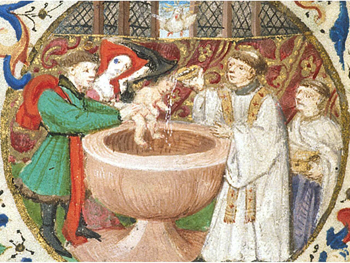 The priest makes the Sign of the Cross over the candidate three times. and says:
The priest makes the Sign of the Cross over the candidate three times. and says:
" Et hoc signum sanctae Crucis..." which in English is, "And this sign of the holy Cross, which we make upon his (her) forehead, do thou, accursed Devil, never dare to violate."
The Priest immediately makes the impression of the Cross on the candidate's forehead. This part concludes with the second laying on of hands and the prayer "Aeternam," in which the Priest implores spiritual gifts for the candidate.
Entrance into the Church
One of the most significant parts of the ritual is the entrance into the Church. Here the candidate is received in the Temple.
The Priest lays the end of his stole on the candidate's shoulder as a symbol of his priestly authority while saying: "N., ingredere in templum Dei ut habeas partem cum Christo in vitam eternam" (N., enter into the Temple of God, that thou mayest have part with Christ unto life everlasting.)
Then, the Priest leads everyone to the baptismal font where he and the godparents pray the Credo and the Pater.
The final solemn exorcism
Now commences the Solemn Exorcism that takes place in the nave of the Church, in the Ancient Roman Rite called "catechization." It begins with those powerful words, "Exorcizo te, omnis spiritus immunde..." (I exorcise thee, every unclean spirit ...) (2)
Ephpheta is the imperative command "Open" in Aramaic, the word spoken by Christ in the cure of the deaf-mute of Decapolis. (3) The Greek Gospel text reads ἐφφαθά, a transliteration of the Aramaic אֶתְפָּתַח or of the Hebrew הפתח, which Mark translates as διανοίχθητι, "Be thou opened." This is also an ancient exorcism rite to which St. Ambrose and St. Ildephonsus of Toledo refer. (4)
The rite is performed by the Priest touching the tips of his fingers with his saliva and placing them in the candidate's ears and nose. In Antiquity it was thought that saliva possessed a virtue against diseases and enchantments, (5) so its use in the ritual has a profound liturgical sense.
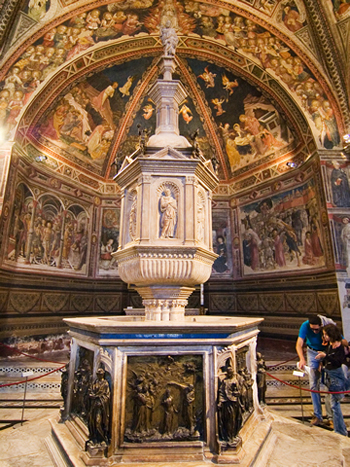 In Gallic lands, saliva was seen as less proper and was replaced by perfumed oil. With this, we can understand why the rite says: "Ut bonum odorem accipiens pietatis aeterne et ut dicas: Christi enim bonus odor sumus Deo" (So that you receive the good aroma of eternal piety and you can say: We are to God the pleasing aroma of Christ).
In Gallic lands, saliva was seen as less proper and was replaced by perfumed oil. With this, we can understand why the rite says: "Ut bonum odorem accipiens pietatis aeterne et ut dicas: Christi enim bonus odor sumus Deo" (So that you receive the good aroma of eternal piety and you can say: We are to God the pleasing aroma of Christ).
Renunciation of Satan
Through the rite of the ephpheta, the expulsion of the Devil is demonstrated in a liturgical way; now the effect becomes personal and patent through the spoken renunciation of the Devil and his pomp.
The Priest asks those three poignant questions: Do your renounce Satan? And all his works? And all his pomps? To each question the sponsor or catechumen solemnly replies "Ab renuntio" (I do renounce him).
Anointing with the oil of the catechumens
Just as before his physical death, the Church anoints a man to prepare him for his last battle with the Devil, so before Baptism the Church establishes a special anointing for the catechumens. This is why St. John Chrysostom says: "They are anointed like athletes who are preparing to enter the stadium." (6)
In the old formula we can find a clear exorcist reference: "Ungo te oleo ad liberationem ab omni spiritu pravo et ad liberationem ab omni malo" (I anoint you with the oil to liberate you from every filthy spirit and every evil). (7)
St. Cyril of Jerusalem similarly states: "You have been anointed with the exorcized oil and have been made participants of the holy oil of Jesus Christ. This oil exorcised by prayer and by the name of God has such great virtue that it makes the invisible demons flee from the soul." (8)
Solemn profession of Faith & Baptism
Then, the Priest removes the violet stole and puts on a white one to proceed with the triple profession of faith. In it he asks the questions: Do you believe in God the Almighty Father? Do you believe in Jesus Christ His Son? Do you believe in the Holy Ghost?
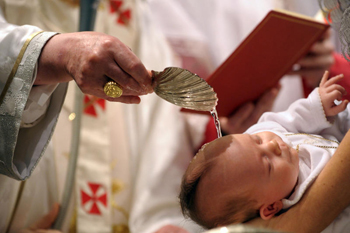 To each question the Sponsor or catechumen responds "Credo," (I do believe).
To each question the Sponsor or catechumen responds "Credo," (I do believe).
The Priest proceeds to baptize the child with the words: "N., ego te baptizo in nomine + Patris et Filii + et Spiritus + Sancti" (I baptize you in the name of the Father, and of the Son and of the Holy Ghost), making the water flow three times.
Baptism must be conferred by immersion or by infusion. Sprinkling water over the head of the candidate does not lawfully confer baptism because the ritual specifically excludes it: The water must be poured over the head.
Today, baptism by immersion in the Latin rite is only preserved in the Mozarabic liturgy of Toledo and in the Ambrosian liturgy of Milan.
Anointing with the Chrism
St. Isidore of Seville states that "not only kings and priests are anointed, but all Christians, who as members are eternal kings and priests" elected people, royal priesthood.(9) Thus does the Priest anoint with chrism the newly-baptized person.
The Priest then takes a white linen cloth – symbolizing the purity of a soul cleaned from all sin – and places it on the head of the candidate. In former times, the newly baptized would don a white alb that he wore for a week.
A lighted candle is given to the sponsor or the newly baptized to denote the light of the Holy Ghost that he has received. This ritual was added in the 11th and 12th centuries.
Blessing of the children
In conclusion, I note that it is a very good custom to carry out the ceremony (10) of the presentation of the child and his consecration to the Blessed Virgin, ceremonies that I transcribe below in Latin and English.
In Latin
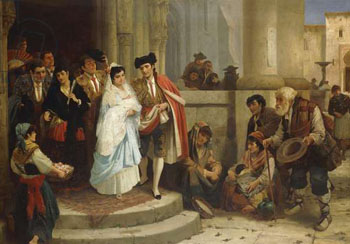 V. Dómine, exáudi oratiónem.
V. Dómine, exáudi oratiónem.
R. Et clamor meus ad te véniat.
V. Dóminus vobíscum.
R. Et cum spíritu tuo.
Oremus.
Quaesumus, Omnipotens Deus Pueris istis, pro quibus tuam deprecamur clementiam, bene+dicere dignare, et per virtutem Sancti Spiritus corda eorum corrobora, vitam sanctifica, castimoniam decora, et sensus eorum in bonis operibus muni et informa: prospera tribue: pacem concede: salutem confer, charitatem largire et ab ómnibus diabolicis, atque humanis insidiis, tua protectione et virtute semper defende, et in finem ad réquiem Paradisii eos perducas. Per Dominum nostrum etc. Amen.
Orémus.
Dómine Jesu Christe, qui párvulos tibi oblátos et ad te veniéntes compléxus es, manúsque super illos impónens benedixísti eis, atque dixísti: Siníte párvulos veníre ad me et nolíte prohibére eos, tálium est enim regnum caelórum, et Ángeli eorum semper vident fáciem Patris mei; réspice, quaésumus, ad púeri (vel puélla) praeséntis inocéntiam, et ad ejus paréntum devotiónem, et cleménter eum (eam) hódie per ministérium nostrum béne + dic; ut in tua grátia et misericórdia Semper profíciat, te sápiat, te díligat, te tímeat, et mandáta tua custódiat, et ad finem optátum felíciter pervéniat: per te Salvátor mundi, qui cum Patre et Spíritu Santo vivis et regnas Deus in saécula saeculórum.
In English
V. Lord, hear my prayer.
R. And let my cry come unto Thee.
V. The Lord be with thee.
R. And with thy spirit.
Let us pray:
We beseech Thee, almighty God, to deign to bless this child, for whom we implore Thy clemency, and to fortify his heart through the strength of the Holy Ghost. Sanctify his life, adorn him with chaste customs, form his senses in the practice of good works: grant him prosperity, peace and health: increase his charity and defend him from all human and devilish snares with Thy protection and power: and in the end grant him the final rest of Paradise. Through Our Lord Jesus Christ, etc. Amen.
Let us pray:
Lord Jesus Christ, to Whom the little ones were given to come to Thy heart, and placing Thy hands on them, Thou didst bless them and say: Suffer the little ones to come to Me and do not forbid them, for theirs is the Kingdom of Heaven and their Angels always see the face of My Father. Look, we beseech Thee, at this boy’s (girl’s) present innocence and the devotion of his (her) parents, and clemently bless him (her) through our ministry; so that he (she) will always benefit from Thy grace and mercy, and might know Thee, love Thee, fear Thee and keep Thy commandments and attain a blissful end: through Thee, the Savior of the world, Whom with the Father and the Holy Ghost livest and reignest forever and ever.
(Holy water is sprinkled)
Consecration to the Blessed Virgin
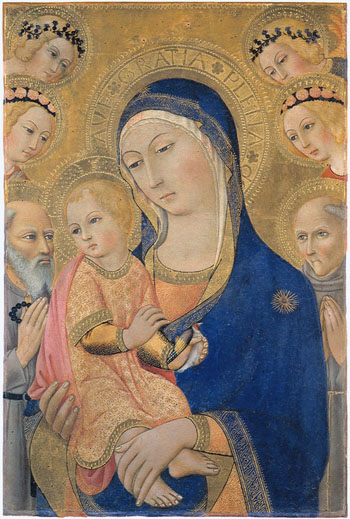 Most Holy Virgin Mary, Mother of God and our Mother, we present Thee this boy (this girl) whom God has given us and entrusted to our care and protection, and who today, through Holy Baptism, has become a son (daughter) of God, a brother (sister) and living member of Thy divine Son Jesus in the Holy Church. We consecrate him (her) to Thee with all our heart, and we trustfully deliver him (her) to Thy tenderness and motherly vigilance.
Most Holy Virgin Mary, Mother of God and our Mother, we present Thee this boy (this girl) whom God has given us and entrusted to our care and protection, and who today, through Holy Baptism, has become a son (daughter) of God, a brother (sister) and living member of Thy divine Son Jesus in the Holy Church. We consecrate him (her) to Thee with all our heart, and we trustfully deliver him (her) to Thy tenderness and motherly vigilance.
By Thy powerful intercession, may God protect him (her) in his (her) soul and body, and preserve him (her) from all evils. If one day he (she) has the misfortune to sin, remind him (her), most loving Mother, that Thou art kind to the repentant sinner, and lead him (her) back to grace and friendship with your Divine Son.
And to us, his (her) parents and godparents, help us to faithfully fulfill our obligations to him (her) and the commitment we have made before God. With our words and especially with our example, may we teach him (her) to believe and practice the truths of the faith, love of neighbor, compliance with the Law of God and respect for His ministers.
Grant us, finally, Blessed Virgin Mary, that someday we may all be joined together in the house of our Heavenly Father, in the intimate embrace of thy Son and in the joy of the Holy Ghost.
Amen.
Continued


Baptism in a medieval manuscript
" Et hoc signum sanctae Crucis..." which in English is, "And this sign of the holy Cross, which we make upon his (her) forehead, do thou, accursed Devil, never dare to violate."
The Priest immediately makes the impression of the Cross on the candidate's forehead. This part concludes with the second laying on of hands and the prayer "Aeternam," in which the Priest implores spiritual gifts for the candidate.
Entrance into the Church
One of the most significant parts of the ritual is the entrance into the Church. Here the candidate is received in the Temple.
The Priest lays the end of his stole on the candidate's shoulder as a symbol of his priestly authority while saying: "N., ingredere in templum Dei ut habeas partem cum Christo in vitam eternam" (N., enter into the Temple of God, that thou mayest have part with Christ unto life everlasting.)
Then, the Priest leads everyone to the baptismal font where he and the godparents pray the Credo and the Pater.
The final solemn exorcism
Now commences the Solemn Exorcism that takes place in the nave of the Church, in the Ancient Roman Rite called "catechization." It begins with those powerful words, "Exorcizo te, omnis spiritus immunde..." (I exorcise thee, every unclean spirit ...) (2)
Ephpheta is the imperative command "Open" in Aramaic, the word spoken by Christ in the cure of the deaf-mute of Decapolis. (3) The Greek Gospel text reads ἐφφαθά, a transliteration of the Aramaic אֶתְפָּתַח or of the Hebrew הפתח, which Mark translates as διανοίχθητι, "Be thou opened." This is also an ancient exorcism rite to which St. Ambrose and St. Ildephonsus of Toledo refer. (4)
The rite is performed by the Priest touching the tips of his fingers with his saliva and placing them in the candidate's ears and nose. In Antiquity it was thought that saliva possessed a virtue against diseases and enchantments, (5) so its use in the ritual has a profound liturgical sense.

The magnificent Baptistery of St. John in Sienna dates to the 14th century
Renunciation of Satan
Through the rite of the ephpheta, the expulsion of the Devil is demonstrated in a liturgical way; now the effect becomes personal and patent through the spoken renunciation of the Devil and his pomp.
The Priest asks those three poignant questions: Do your renounce Satan? And all his works? And all his pomps? To each question the sponsor or catechumen solemnly replies "Ab renuntio" (I do renounce him).
Anointing with the oil of the catechumens
Just as before his physical death, the Church anoints a man to prepare him for his last battle with the Devil, so before Baptism the Church establishes a special anointing for the catechumens. This is why St. John Chrysostom says: "They are anointed like athletes who are preparing to enter the stadium." (6)
In the old formula we can find a clear exorcist reference: "Ungo te oleo ad liberationem ab omni spiritu pravo et ad liberationem ab omni malo" (I anoint you with the oil to liberate you from every filthy spirit and every evil). (7)
St. Cyril of Jerusalem similarly states: "You have been anointed with the exorcized oil and have been made participants of the holy oil of Jesus Christ. This oil exorcised by prayer and by the name of God has such great virtue that it makes the invisible demons flee from the soul." (8)
Solemn profession of Faith & Baptism
Then, the Priest removes the violet stole and puts on a white one to proceed with the triple profession of faith. In it he asks the questions: Do you believe in God the Almighty Father? Do you believe in Jesus Christ His Son? Do you believe in the Holy Ghost?

Baptism must be conferred by immersion or pouring
The Priest proceeds to baptize the child with the words: "N., ego te baptizo in nomine + Patris et Filii + et Spiritus + Sancti" (I baptize you in the name of the Father, and of the Son and of the Holy Ghost), making the water flow three times.
Baptism must be conferred by immersion or by infusion. Sprinkling water over the head of the candidate does not lawfully confer baptism because the ritual specifically excludes it: The water must be poured over the head.
Today, baptism by immersion in the Latin rite is only preserved in the Mozarabic liturgy of Toledo and in the Ambrosian liturgy of Milan.
Anointing with the Chrism
St. Isidore of Seville states that "not only kings and priests are anointed, but all Christians, who as members are eternal kings and priests" elected people, royal priesthood.(9) Thus does the Priest anoint with chrism the newly-baptized person.
The Priest then takes a white linen cloth – symbolizing the purity of a soul cleaned from all sin – and places it on the head of the candidate. In former times, the newly baptized would don a white alb that he wore for a week.
A lighted candle is given to the sponsor or the newly baptized to denote the light of the Holy Ghost that he has received. This ritual was added in the 11th and 12th centuries.
Blessing of the children
In conclusion, I note that it is a very good custom to carry out the ceremony (10) of the presentation of the child and his consecration to the Blessed Virgin, ceremonies that I transcribe below in Latin and English.
In Latin

A baptism in a Spanish village in the 1830s
R. Et clamor meus ad te véniat.
V. Dóminus vobíscum.
R. Et cum spíritu tuo.
Oremus.
Quaesumus, Omnipotens Deus Pueris istis, pro quibus tuam deprecamur clementiam, bene+dicere dignare, et per virtutem Sancti Spiritus corda eorum corrobora, vitam sanctifica, castimoniam decora, et sensus eorum in bonis operibus muni et informa: prospera tribue: pacem concede: salutem confer, charitatem largire et ab ómnibus diabolicis, atque humanis insidiis, tua protectione et virtute semper defende, et in finem ad réquiem Paradisii eos perducas. Per Dominum nostrum etc. Amen.
Orémus.
Dómine Jesu Christe, qui párvulos tibi oblátos et ad te veniéntes compléxus es, manúsque super illos impónens benedixísti eis, atque dixísti: Siníte párvulos veníre ad me et nolíte prohibére eos, tálium est enim regnum caelórum, et Ángeli eorum semper vident fáciem Patris mei; réspice, quaésumus, ad púeri (vel puélla) praeséntis inocéntiam, et ad ejus paréntum devotiónem, et cleménter eum (eam) hódie per ministérium nostrum béne + dic; ut in tua grátia et misericórdia Semper profíciat, te sápiat, te díligat, te tímeat, et mandáta tua custódiat, et ad finem optátum felíciter pervéniat: per te Salvátor mundi, qui cum Patre et Spíritu Santo vivis et regnas Deus in saécula saeculórum.
In English
V. Lord, hear my prayer.
R. And let my cry come unto Thee.
V. The Lord be with thee.
R. And with thy spirit.
Let us pray:
We beseech Thee, almighty God, to deign to bless this child, for whom we implore Thy clemency, and to fortify his heart through the strength of the Holy Ghost. Sanctify his life, adorn him with chaste customs, form his senses in the practice of good works: grant him prosperity, peace and health: increase his charity and defend him from all human and devilish snares with Thy protection and power: and in the end grant him the final rest of Paradise. Through Our Lord Jesus Christ, etc. Amen.
Let us pray:
Lord Jesus Christ, to Whom the little ones were given to come to Thy heart, and placing Thy hands on them, Thou didst bless them and say: Suffer the little ones to come to Me and do not forbid them, for theirs is the Kingdom of Heaven and their Angels always see the face of My Father. Look, we beseech Thee, at this boy’s (girl’s) present innocence and the devotion of his (her) parents, and clemently bless him (her) through our ministry; so that he (she) will always benefit from Thy grace and mercy, and might know Thee, love Thee, fear Thee and keep Thy commandments and attain a blissful end: through Thee, the Savior of the world, Whom with the Father and the Holy Ghost livest and reignest forever and ever.
(Holy water is sprinkled)
Consecration to the Blessed Virgin

A highly recommended tradition: Consecration of a child to Our Lady
By Thy powerful intercession, may God protect him (her) in his (her) soul and body, and preserve him (her) from all evils. If one day he (she) has the misfortune to sin, remind him (her), most loving Mother, that Thou art kind to the repentant sinner, and lead him (her) back to grace and friendship with your Divine Son.
And to us, his (her) parents and godparents, help us to faithfully fulfill our obligations to him (her) and the commitment we have made before God. With our words and especially with our example, may we teach him (her) to believe and practice the truths of the faith, love of neighbor, compliance with the Law of God and respect for His ministers.
Grant us, finally, Blessed Virgin Mary, that someday we may all be joined together in the house of our Heavenly Father, in the intimate embrace of thy Son and in the joy of the Holy Ghost.
Amen.
Continued
- Radó, Polycarpus, Enchiridion Liturgicum (Roma: Herder, 1961), p. 690, c. 1.
- "I exorcise thee, every unclean spirit, in the name of God the Father + Almighty, in the name of Jesus + Christ, His Son, our Lord and Judge, and in the power of the Holy + Spirit, that thou be depart from this creature of God N, which our Lord hath deigned to call unto His holy temple, that it may be made the temple of the living God, and that the Holy Spirit may dwell therein. Through the same Christ our Lord, who shall come to judge the living and the dead, and the world by fire."
- Mk 7:31–37.
- Lib. De Mysteriis, I; De cognit. Bapt. C. 29. PL. 96, 124.
- Abbé R, Aigrain, Liturgia (París: Encyclopédie populaire des connaissances liturgiques, Librairíe Bloudet Gay, 1947) p. 768.
- In coloss. c. 2. hom. 6,4.
- J. Testam, c. 8. (ed. J. Rahmani, Mainz, 1899) p. 129: “I anoint thee to liberate thee from all perverse spirits and from all evil.”
- III Catech. Mystag., 3.
- Decreti di Nic. Sfondrati p. 7 c. 9.
- Aporti, Ferrante, Memorie di storiae cclesiatica Cremonese. Dall'Anno 1335 al 1590 Dell'Era Volgare, Vol. 2. 1837) p. 188.

Posted December 14, 2018















